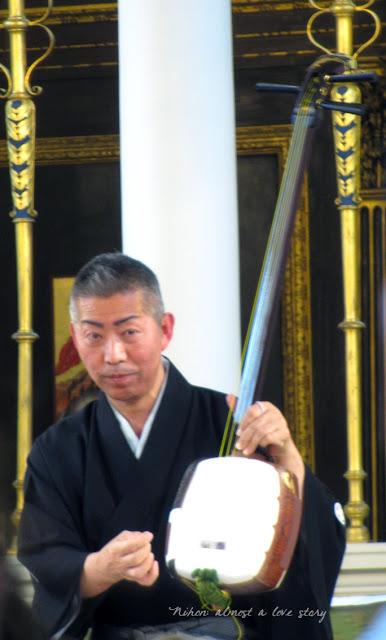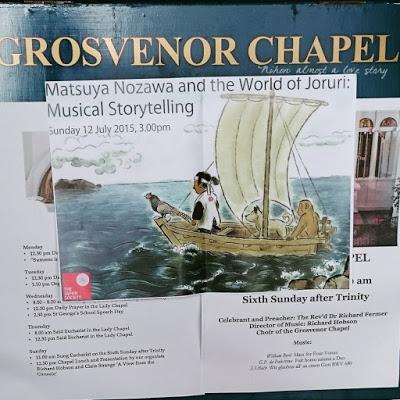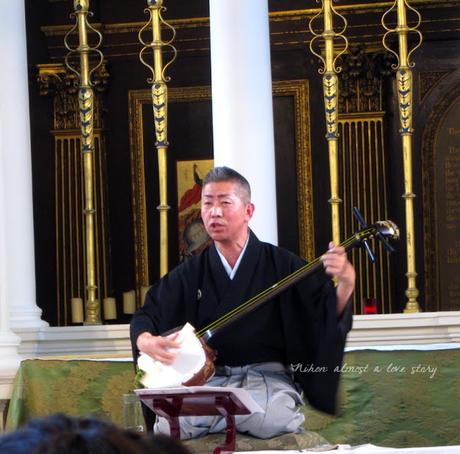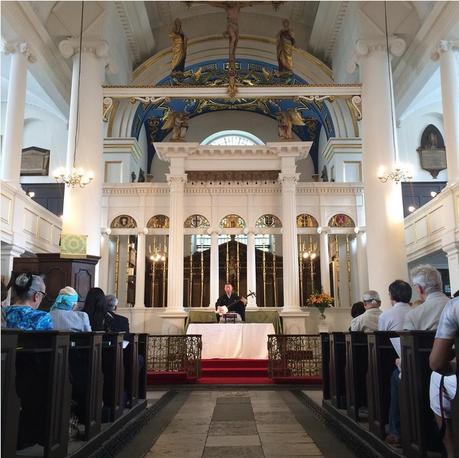 [English version below]
[English version below]Matsuya Nozawa 野澤松也 è un suonatore di gidayu shamisen presso il National Theatre of Japan ed è riconosciuto come uno dei Tesori Nazionali Viventi del Giappone.
Durante un breve tour europeo ha fatto tappa anche a Londra, a Grosvenor Chapel, grazie alla Japan Society. È stato un evento di introduzione al jōruri 浄瑠璃, una forma di musica tradizionale che enfatizza la parte narrativa dell’esibizione rispetto a quella puramente musicale. Il jōruri fa solitamente da accompagnamento al teatro kabuki o al bunraku (rappresentazioni di marionette), prendendo forme e stili diversi per l’uno o per l’altro. In entrambi i casi il suono dello shamisen 三味線 accentua un’azione, accompagna i movimenti, enfatizza i sentimenti dei personaggi sul palcoscenico. Utilizzando note e tocchi delle corde codificati il suonatore suggerisce al pubblico in modo infallibile cosa sta accadendo, qual è l’umore della scena.
Lo shamisen non è uno strumento indigeno del Giappone, ma è giunto dall’Asia continentale attraverso il regno di Ryūkyū e da lì è arrivato al porto di Osaka. A differenza del sanshin di Okinawa da cui ha origine, lo shamisen è stato influenzato dal biwa, altro strumento a corde, ed ha la peculiarità di un caratteristico suono vibrato.
Matsuya Nozawa, consapevole della durata impegnativa e del linguaggio a volte ostico del jōruri, ha innovato il genere per renderlo più accessibile, semplificando le opere storiche nel vocabolario e abbreviandole, mantenendo però le atmosfere e i suoni tramandati fin dal periodo Edo.
Domenica 12 luglio si è esibito a Londra con tre opere: il classico della letteratura tradizionale Momotarō, in cui un ragazzino nato da una pesca parte a caccia di demoni in compagnia di un cane, un fagiano e una scimmia; Oitekebori, in cui un fantasma che vive nei canali terrorizza due pescatori; infine la storia dello scontro sul ponte di Gojō, a Kyoto, tra il monaco guerriero Benkei e il generale Miyamoto no Yoshitsune.

Assistere a un’esibizione di musica tradizionale giapponese all’interno di una chiesa ha un non so che di inaspettato, i suoni fuori dal loro normale contesto prendono più coraggio e li si riesce quasi a cogliere meglio, a prestare loro completa attenzione. Immaginate: un Tesoro Nazionale Vivente, in un elegante kimono, in ginocchio sopra all’altare con uno shamisen tra le braccia. Intorno a lui colonne bianche e decorazioni dorate, sopra la sua testa un imponente crocifisso, e nell’aria la sua voce potente e il suono vibrante delle corde dello strumento, toccate con maestria e dita veloci. Non è uno spettacolo che si vede tutti i giorni.
 English:
English:Matsuya Nozawa 野澤松也 is a gidayu shamisen performer at the National Theatre of Japan, and is recognized as one of Japan’s Living National Treasures.
On a short European tour he stopped in London, thanks to Japan Society. He performed at Grosvenor Chapel for an introduction to jōruri 浄瑠璃 – a form of traditional storytelling performance with emphasis on lyrics and narration rather than music itself. It usually accompanies kabuki and bunraku (puppet theatre), taking for each different forms and styles. Both for kabuki and bunraku the sound of shamisen 三味線 stresses an action, follows the movements of actors or puppets, highlights the feelings of characters on stage. Through a codified use of notes and ways of touching the strings the performer can suggest what is happening, what’s the mood of a particular scene.
Shamisen was not born in Japan, it arrived from continental Asia through the Kingdom of Ryūkyū, and from there to the port of Osaka. Unlike Okinawa sanshin, shamisen was influenced by biwa and it has a peculiar vibrato sound that is missing in the Okinawan instrument.

Matsuya Nozawa, realising that jōruri can be hard to follow due to its lenght and difficult language, decided to innovate the genre and make it more accessible. He simplified and shortened traditional works, maintaining original sounds and atmospheres dating to Edo period.
On Sunday 12th July he performed three works: first, the traditional folklore tale of Momotarō, a boy who was born from a peach and sets out hunting for demons supported by a dog, a pheasant and a monkey. Second was Oitekebori, about a ghost lurking in a canal and scarying two fishermen. Last, the story of the battle between the warrior-monk Benkei and General Miyamoto no Yoshitsune, that took place at Gojō bridge in Kyoto.

picture by Japan Society London
Attending a performance of traditional Japanese music in a church was quite unexpected. The sounds, outside their natural context, get more intense and one can almost catch them better, giving them full attention. Picture this: a Living National Trasure wearing an elegant kimono is kneeling on the altar with a shamisen in his arms. Around him are white columns and golden adornments, over his head an awe-inspiring crucified Christ. In the air his powerful voice and the vibrating sound of shamisen strings, touched with fast and trained fingers. It’s not everyday you see something like this.

